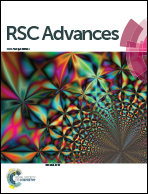Ultrafine MoO2 nanoparticles encapsulated in a hierarchically porous carbon nanofiber film as a high-performance binder-free anode in lithium ion batteries
Abstract
Flexible free-standing hierarchically porous carbon nanofibers embedded with ultrafine (∼3.5 nm) MoO2 nanoparticles (denoted as MoO2@HPCNFs) have been synthesized by electrospinning and subsequent heat treatment. When evaluated as a binder-free anode in Li-ion batteries, the as-obtained MoO2@HPCNFs film exhibits excellent capacity retention with high reversible capacity (≥1055 mA h g−1 at 100 mA g−1) and good rate capability (425 mA h g−1 at 2000 mA g−1), which is much superior to most of the previously reported MoO2-based materials. The synergistic effect of uniformly dispersed ultrasmall MoO2 nanoparticles and a three-dimensionally hierarchical porous conductive network constructed by HPCNFs effectively improve the utilization rate of active materials, enhance the transport of both electrons and Li+ ions, facilitate the electrolyte penetration, and promote the Li+ storage kinetics and stability, thus leading to a greatly enhanced electrochemical performance.



 Please wait while we load your content...
Please wait while we load your content...